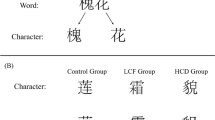Abstract
The perception of a letter in the context of a word is easier than in the context of a random letter sequence. It appears that our knowledge about words can influence our perception process. McClelland and Rumelhart (1981) propose an interactive activation model to account for the interaction between our knowledge about words and our visual input. They use their model to explain how these interactions facilitate perception. In their account, word context effect is a constant independent of the identity of the words. In this paper, we propose the use of informatin theory to quantify word context effect. In this way, the strength of word context effect will depend on the identity of the words. We apply the method to quantify word context effect in Chinese words. This knowledge is encoded in an artificial neural network using the interactive activation and competition model. The network is used to recognize Chinese characters and we are able to achieve a high recognition rate.
Similar content being viewed by others
References
Gan KW (1991) Connectionist method for Chinese character recognition. M. Sc thesis, National University of Singapore
Gan KW, Lua KT (1991) A new approach to stroke and feature point extraction in Chinese character recognition. Pattern Recogn Letters: (to be published)
Kandel A (1982) Fuzzy techniques in pattern recognition. Wiley, New York
Lua KT (1990) From character to word — an application of information theory. Comput Process Chin Orien Lang 4:304–313
Lua KT, Gan KW (1990) Recognizing Chinese characters through interactive activation and competition. Pattern Recogn 23:1311–1321
MacQueen JB (1967) Some methods for classification and analysis of multivariate observations. Proceedings, Symposium on Mathematical Statistics and Probability, Berkeley, pp 281–297
McClelland JL (1988) Putting knowledge in its place: a scheme for programming parallel processing structures on the fly. In: Waltz D, Feldman JA (eds) Connectionist models and their implications. Ablex, Norwood, N.J. pp 63–96
McClelland JL, Rumelhart DE (1981) An interactive activation model of context effects in letter perception: part 1. An account of basic findings. Psychol Rev 88:375–407
Reicher GM (1969) Perceptual recognition as a function of meaningfulness of stimulus material. Exp Psychol 81:274–280
Shannon CE (1948) A mathematical theory of communication. Bell Syst Tech J 27:379–423
Author information
Authors and Affiliations
Rights and permissions
About this article
Cite this article
Gan, K.W., Lua, K.T. Representing word context effect in Chinese character perception — an application of information theory. Biol. Cybern. 65, 479–485 (1991). https://doi.org/10.1007/BF00204661
Received:
Accepted:
Issue Date:
DOI: https://doi.org/10.1007/BF00204661



